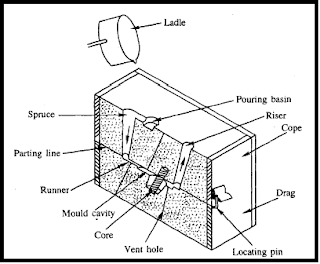Casting is a manufacturing process by which a liquid material is usually poured into a mold, which contains a hollow cavity of the desired shape, and then allowed to solidify. The solidified part is also known as a casting, which is ejected or broken out of the mold to complete the process. Casting materials are usually metals or various cold setting materials that cure after mixing two or more components together; examples are epoxy, concrete, plaster and clay. Casting is most often used for making complex shapes that would be otherwise difficult or uneconomical to make by other methods.
In other word we can say " casting is a process in which molten metal or non-metal material is poured in the mold cavity and allow to solidifies for specified period of time and thereafter molten material began solid state of desire shape."
Casting is a 6000 year old process. The oldest surviving casting is a copper frog from 3200 BC
A large number of metal components in designs we use every day are made by casting. The reasons for this
Include:
(a) Casting can produce very complex geometry parts with internal cavities and hollow sections.
(b) It can be used to make small (few hundred grams) to very large size parts (thousands of kilograms)
(c) It is economical, with very little wastage: the extra metal in each casting is re-melted and re-used
(d) Cast metal is isotropic – it has the same physical/mechanical properties along any direction.
Answered by Manosh Ganguly
student OCC (Online coaching Class)
www.onlinecoachingclass.org





No comments:
Post a Comment